Abstract
In vitro rooting as one of the most critical steps of micropropagation is affected by various extrinsic (e.g., medium composition, auxins) and intrinsic factors (e.g., species, explant). In Passiflora species, in vitro adventitious rooting is a difficult, complex, and non-linear process. Since in vitro rooting is a multivariable complex biological process, efficient and reliable computational approaches such as machine learning (ML) are required to model, predict, and optimize this non-linear biological process. Therefore, in the current study, a hybrid of generalized regression neural network (GRNN) and genetic algorithm (GA) was employed to predict in vitro rooting responses (rooting percentage, number of roots, and root length) of Passiflora caerulea based on the optimization of the level of auxins (indole-3-acetic acid (IAA), indolebutyric acid (IBA), and 1-naphthaleneacetic acid (NAA)) and the type of explant (microshoots derived from leaf, node, and internode). Based on the results, the GRNN model was accurate in predicting all in vitro rooting responses of P. caerulea (R2 > 0.92) in either training or testing sets. The result of the validation experiment also showed that there was a negligible difference between the predicted-optimized values and the validated results demonstrating the reliability of the developed GRNN-GA model. Generally, the results of the current study showed that GRNN-GA is a reliable and accurate model to predict and optimize in vitro rooting of P. caerulea.
1. Introduction
Passiflora caerulea L. (Passifloraceae family) is an evergreen and climbing Passiflora species that is cultivated in tropical and subtropical regions [1,2]. P. caerulea has been widely used in medicinal and horticultural industries due to its edible fruits, beautiful flowers, and valuable secondary metabolites (e.g., phenols, alkaloids, glycosides, flavonoids, and saponins) [3,4]. Different propagation (i.e., sexual and asexual) methods can be used to propagate P. caerulea [5,6]. Although asexual propagation through seeds is the most common approach for the propagation of P. caerulea, a high degree of genetic diversity is the most important problem of this propagation method [7]. On the other hand, asexual propagation through cutting and grafting can result in virus outbreaks [8]. Hence, in vitro propagation has become a reliable and useful method for producing disease-free clonal P. caerulea [2,3].
Plant regeneration is a key character of in vitro propagation, and rhizogenesis (i.e., in vitro adventitious rooting) of microshoots is a critical stage for the success of micropropagation [9,10]. In Passiflora species, in vitro adventitious rooting is a difficult and complex process [8]. The adventitious rooting process is affected by various factors ranging from endogenous levels of biochemical components and genetics (e.g., species and explant) to environmental conditions (e.g., medium composition, carbohydrate sources, plant growth regulators (PGRs) such as auxins, gelling agent, light spectra, light intensity, and temperature) [11] (Figure 1). The conventional analytical techniques for modeling in vitro growth and development are cost and time consuming and sometimes become ineffective because of the existing complex system [12]. To overcome these limitations during the establishment and development of in vitro propagation protocol, new and reliable computational strategies such as machine learning (ML) should be employed [11].
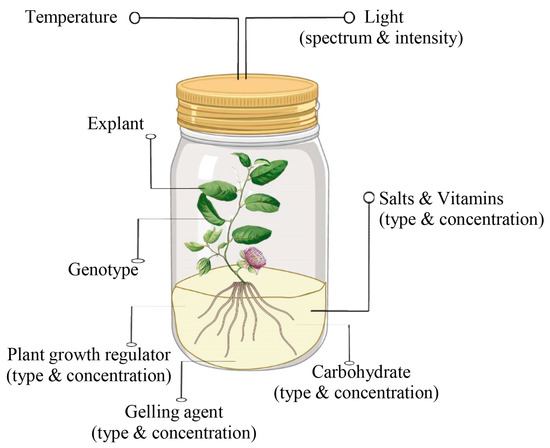
Figure 1.
Schematic representation of factors affecting in vitro rooting of P. caerulea.
Machine learning as an evolving sub-branch of artificial intelligence (AI) has a great potential to solve a wide range of complex problems in biological systems [13,14,15]. Indeed, ML aims to recognize the pattern within a given dataset and then develop a predictive model based on mathematical rules without specific step-by-step programming [16,17,18]. In the plant tissue culture, different ML algorithms have been recently used for developing and optimizing in vitro propagation protocols in different species such as chrysanthemum [19,20,21,22,23,24], Prunus rootstock [9,25,26], cannabis [27,28,29,30,31], ajowan [32], wheat [33], wallflower [34], chickpea [35], tomato [36], and walnut [37]. The reliability and accuracy of artificial neural networks (ANNs) as one of the most well-known ML have been approved in different in vitro culture studies [11,12]. It has been shown that generalized regression neural network (GRNN) as one of the most powerful of ANNs has more accuracy than other ANNs in modeling and forecasting in vitro culture procedures [28,30,33,38].
In addition to ML, optimization algorithms such as genetic algorithm (GA) can be used for the optimization of in vitro culture systems [9,11]. Several studies have proposed a hybrid of GRNN and GA as a powerful and reliable method for the prediction, modeling, and optimization of in vitro propagation protocols in different species [28,29,30,33]. However, there exists no report on using ML methods on in vitro P. caerulea propagation. Therefore, the objectives of the present study were (i) evaluating the effect of PGRs and type of explant on in vitro adventitious rooting of P. caerulea, (ii) using GRNN for modeling and prediction of in vitro adventitious rooting of P. caerulea, and finally (iii) employing GA as a single-objective evolutionary optimization algorithm to optimize the level of PGRs and explant for in vitro adventitious rooting of P. caerulea.
2. Materials and Methods
2.1. Plant Material, Culture Medium, and Growth Conditions
In the present investigation, in vitro grown microshoots derived from different explants (i.e., leaf, node, internode) were used as initial material for studying the in vitro rooting of P. caerulea. MS [39] along with 0.7% agar and 3% sucrose was used as the basal medium in this study. Different auxins (i.e., indole-3-acetic acid (IAA), indolebutyric acid (IBA), and 1-naphthaleneacetic acid (NAA)) at various concentrations (0, 0.5, 1.0, 2.0 mg/L) were used for studying the rooting of in vitro grown P. caerulea microshoots. Prior to autoclaving for 20 min at 120 °C, the pH of the media was adjusted to 5.8. For each treatment, 30 mL medium was poured into each glass jar.
In vitro rooting experiment was conducted based on a randomized complete block design (three blocks) with sampling (ten samples) with the factorial arrangement including two factors (i.e., explants and auxins). Each glass jar contained one microshoot. All glass jars were kept in the growth chamber at 25 ± 2 °C under 16 h photoperiod with 45 ± 4 μmol m−2 s−1 light intensity.
2.2. Modeling Procedures
In the current study, GRNN was employed to model and predict in vitro rooting of P. caerulea. Before using the GRNN model, Box-Cox transformation was applied to normalize the data (Figure 2).
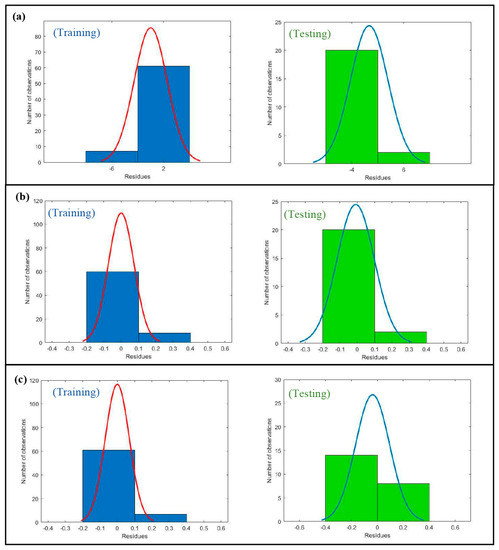
Figure 2.
Histogram of residuals in training sets and testing sets of (a) rooting percentage, (b) root number, and (c) root length in P. caerulea.
To detect outliers, principal component analysis (PCA) was used; however, no outlier was identified. Different auxins (IBA, IAA, and NAA) and explants (i.e., in vitro grown microshoots derived from different explants including leaf, node, internode) were selected as input variables, while rooting percentage, number of roots, and root length were considered target (output) variables (Figure 3). Additionally, 75% and 25% of dataset were, respectively considered for training and testing sets.
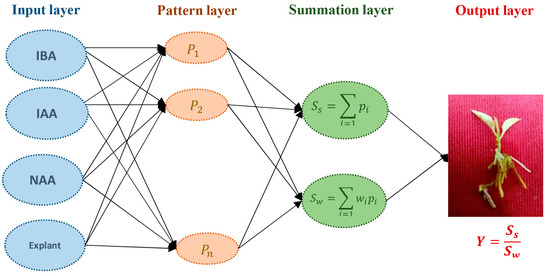
Figure 3.
Schematic representation of generalized regression neural network (GRNN) algorithm.
To evaluate the efficiency and accuracy of the models, root mean square error (RMSE), R2 (coefficient of determination), and mean absolute percentage error (MAPE) were employed.
2.3. Sensitivity Analysis
Sensitivity analysis was performed to detect the importance degree of NAA, IBA, IAA, and explants on in vitro rooting of P. caerulea. The sensitivity of these parameters was calculated by the criteria including variable sensitivity error (VSE) value showing the RMSE of GRNN model when that input variable is removed from the model. Variable sensitivity ratio (VSR) value was calculated as ratio of VSE and GRNN model error (RMSE value) when all input variables are available. A higher important variable in the model was determined by higher VSR.
MATLAB (R2018b, The MathWorks Inc., Natick, MA, USA) software was employed for writing all the codes.
2.4. Optimization Process via Genetic Algorithm (GA)
GA as a single-objective evolutionary optimization algorithm was used for finding the appropriate concentrations of auxins (IBA, IAA, and NAA) and type of explant (leaf, node, internode) to obtain the highest in vitro rooting responses (rooting percentage, number of roots, and root length). The upper bound and lower bound of the dataset were considered as constraints, and the point with the highest value for each studied in vitro rooting response was recognized as the optimal solution. Roulette wheel as a selection function, 2-point crossover function, and the uniform of mutation function were considered during the optimization process. The crossover rate, generation number, initial population, and mutation rate were, respectively set to 0.7, 1000, 200, and 0.04 to obtain the best fitness (Figure 4).
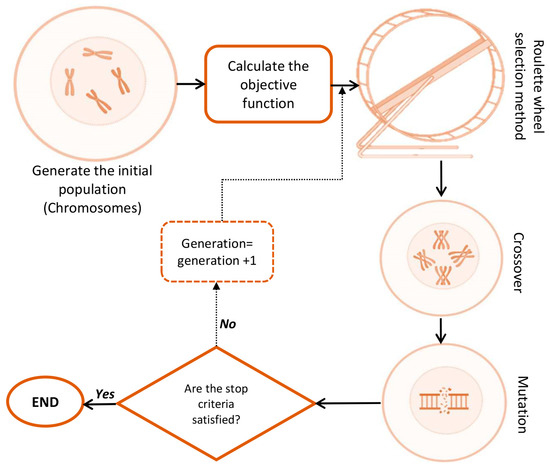
Figure 4.
Schematic representation of genetic algorithm (GA).
2.5. Validation Experiment
To confirm the efficiency and reliability of the developed model (GRNN-GA), the predicted-optimized outcomes for in vitro rooting responses (rooting percentage, number of roots, and root length) were experimentally tested with 3 replications and each replication contained 10 microshoots.
3. Results
3.1. Effect of Type and Concentration of Auxins as Well as Type of Explants on In Vitro Rooting of P. caerulea
In the present investigation, the effect of different types (IBA, NAA, IAA) and concentrations (0, 0.5, 1, and 2 mg/L) of auxins were investigated on in vitro rooting of P. caerulea. Based on Table 1, various in vitro rooting responses were examined in different combinations of auxins as well as type of explant. Based on our results (Table 1), there exists no in vitro rooting in the medium without auxins. Instead, the microshoots-derived from different explants were elongated due to cell elongation and microshoot growth. However, the presence of 1 mg/L IBA in the medium resulted in the maximum (90%) rooting percentage in microshoots derived from leaf and node explants (Table 1). Additionally, 1 mg/L IBA led to the highest root number (9.83 ± 0.088) in microshoots derived from leaf explant (Table 1). Moreover, the highest root length (5.87 ± 0.033 cm) was obtained from either leaf or node explants cultured in MS medium containing 1 mg/L NAA (Table 1). Generally, IAA resulted in the minimum in vitro rooting responses of P. caerulea (Table 1).

Table 1.
Effect of type and concentration of auxins as well as type of explants on in vitro rooting of P. caerulea.
3.2. The Efficiency of GRNN in Modeling and Predicting In Vitro Rooting of P. caerulea
In the current study, GRNN as one of the most well-known ANNs was applied to model and predict in vitro rooting responses of P. caerulea to various types of explants and auxins (NAA, IBA, IAA).
To assess the accuracy and efficiency of the developed GRNN models, different performance criteria including R2, RMSE, and MAPE were applied. As can be seen in Table 2, the GRNN model was accurate in predicting all in vitro rooting responses of P. caerulea including rooting percentage (R2 > 0.93), root number (R2 > 0.92), and root length (R2 > 95) in either training or testing sets.

Table 2.
Performance criteria of GRNN model for in vitro rooting of P. caerulea in training and testing sets.
Moreover, the correlations between observed and predicted data demonstrated a good fit for the developed models (Figure 5).
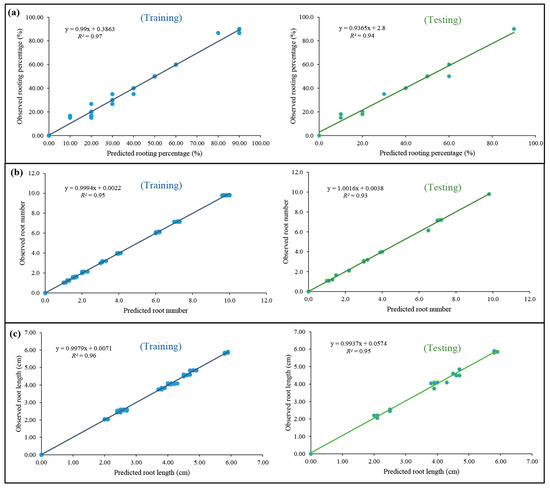
Figure 5.
Scatter plot of values of observations vs. predictions in training sets and testing sets of (a) rooting percentage, (b) root number, and (c) root length in P. caerulea.
3.3. The Importance of Input Variables in In Vitro Rooting of P. caerulea
Sensitivity analysis was performed to rank the importance of each input variable. Based on the results (Table 3), IBA > NAA > IAA > explant was ranked for both rooting percentage and root number. However, for root length, NAA was the most important parameter followed by IBA, IAA, and explant, respectively (Table 3).

Table 3.
Determining the importance of factors involved in in vitro rooting of P. caerulea through sensitivity analysis.
3.4. Application of GRNN-GA for Determining the Optimal Concentration of Auxin as Well as the Type of Explant to Maximize In Vitro Rooting of P. caerulea
To determine the optimal level of auxins as well as the type of explant, the developed GRNN model was linked to GA. Based on the GRNN-GA results (Table 4), the highest rooting percentage (90%) can be obtained from leaf explants cultured in MS medium supplemented with 0.64 mg/L IBA plus 0.33 mg/L NAA plus 0.15 mg/L IAA. Additionally, the maximum root number (9.83) would be obtained from leaf explants cultured in MS medium supplemented with 0.57 mg/L IBA plus 0.23 mg/L NAA plus 0.19 mg/L IAA (Table 4). Moreover, the highest root length (5.81 cm) can be obtained from leaf explants cultured in MS medium supplemented with 0.39 mg/L IBA plus 0.82 mg/L NAA plus 0.24 mg/L IAA (Table 4).

Table 4.
The results of optimization process via GA as well as the validation experiment for in vitro rooting of P. caerulea.
To confirm the reliability of the developed GRNN-GA, the predicted-optimized results for in vitro rooting responses of P. caerulea (rooting percentage, root number, and root length) were experimentally tested. The result of the validation experiment (Table 4) showed that there were no significant differences between the predicted-optimized values and the validated results.
4. Discussion
In vitro rooting is one of the most critical stages in the establishment of micropropagation protocols [9]. Since in vitro rooting is a multivariable biological process that is influenced by extrinsic (e.g., medium composition and PGRs) and intrinsic (e.g., species and explant) factors, ML methods are well-fitted to accurately model and predict in vitro rooting outcomes [11]. Among intrinsic and extrinsic factors, the type of explant as well as type and concentration of PGRs play an important role in rhizogenesis and directly impact the growth of in vitro-grown plantlets [8]. Hence, in the present investigation, the effect of various levels of auxins (IBA, NAA, and IAA) and different types of explants (leaf, node, internode) on in vitro rooting of P. caerulea by using a hybrid of GRNN and GA was studied.
Our results showed that GRNN had a great performance in modeling and predicting in vitro rooting of P. caerulea. In line with our results, previous studies have approved the efficiency and accuracy of GRNN in different in vitro culture stages such as in vitro shoot growth and development [28], plant regeneration [33], in vitro seed germination [30], and in vitro secondary metabolite production [38]. The GRNN is a kind of regression tool and also a probabilistic neural network with a dynamic network structure which was developed by Specht [40]. GRNN can effectively model non-linear systems (e.g., in vitro culture systems) due to its high robustness, high fault tolerance, simplicity of network structure, and strong non-linear mapping capability [41,42]. Hence, GRNN has been widely employed in different fields such as wind speed forecasting [43], exchange rates forecasting [44], medicinal chemistry [45], batch processes [46], and pattern recognition [47].
To find the optimal level of auxins and type of explant in in vitro rooting of P. caerulea, a GA was linked to the GRNN. GA as a search algorithm is a single objective evolutionary optimization algorithm that is inspired by natural selection and genetics concepts [11]. The basic concepts of GA are the generation of the initial population to search for possible solutions and then for elite solutions which are employed for crossover by using selection methods (e.g., tournament and roulette wheel), which will finally choose the best solution among possible elites [28]. The result of the validation experiment of the current study also showed that there was a negligible difference between the predicted-optimized values and the validated results demonstrating the reliability of the developed GRNN-GA model. In line with our results, previous studies showed that GA can be used as a reliable and efficient optimization algorithm to optimize various in vitro propagation systems [28,29,30,33].
Based on the sensitivity analysis results, IBA > NAA > IAA > explant was ranked for both rooting percentage and root number. Similar to our results, previous studies have also demonstrated that IBA and NAA were the most important auxins for in vitro rooting of Passiflora species [5,7,8]. For instance, Anand et al. [7] reported that a combination of IBA and NAA was the best treatment for in vitro rooting of P. foetida. Additionally, Boboc Oros et al. [8] showed that NAA and IBA were the best auxins for in vitro rooting of P. quadrangularis. Based on our results, the type of explant had the minimum importance in in vitro rooting of P. caerulea. Previous studies have also shown that the type of explants plays an indirect role in in vitro rooting of Passiflora species [1,2,3,48]. Since microshoots- derived from different types of explants are completely developed during plant regeneration, the type of explant has the minimum effects on in vitro rooting [49,50]. In fact, the effects of the type of explants rely on the endogenous phytohormones within the microshoots [51]. Generally, the results of the current study showed that GRNN-GA is a reliable and accurate model to predict and optimize in vitro rooting of P. caerulea.
5. Conclusions
Various factors such as type and concentrations of auxins and type of explant affect in vitro rooting of P. caerulea. Optimizing in vitro rooting can be considered as one of the most important steps to establish a whole plantlet propagation protocol. Recently, different ML algorithms have been widely implemented to predict and optimize plant tissue culture systems. In this study, GRNN was employed for the prediction and optimization of in vitro rooting of P. caerulea. Based on our results, the developed GRNN model can accurately model and predict in vitro rooting of P. caerulea. In addition, our results demonstrated that GA was able to accurately find the optimized level of auxin and explant to maximize in vitro rooting of P. caerulea. The results of the present investigation show that the hybrid of GRNN and GA can open a helpful window for modeling and understanding in vitro propagation and can pave the way for further in vitro culture studies (e.g., direct and indirect organogenesis and somatic embryogenesis) in P. caerulea.
Author Contributions
Conceptualization, M.J. and M.H.D.; methodology, M.J. and S.J.; software, M.J.; validation, M.J. and S.J.; formal analysis, M.J. and M.H.; investigation, M.J.; resources, M.J. and M.H.D.; data curation, M.J. and M.H.; writing—original draft preparation, M.J. and M.H.; writing—review and editing, M.J., S.J., M.H.D. and M.H.; visualization, M.J. and M.H.; supervision, M.H.D.; project administration, M.H.D. All authors have read and agreed to the published version of the manuscript.
Funding
This research received no external funding.
Data Availability Statement
All relevant data are within the paper.
Conflicts of Interest
The authors declare no conflict of interest.
References
- Pacheco, G.; Simão, M.J.; Vianna, M.G.; Garcia, R.O.; Vieira, M.L.C.; Mansur, E. In vitro conservation of Passiflora—A review. Sci. Hortic. 2016, 211, 305–311. [Google Scholar] [CrossRef]
- Jafari, M.; Daneshvar, M.H.; Lotfi, A. In vitro shoot proliferation of Passiflora caerulea L. via cotyledonary node and shoot tip explants. BioTechnologia 2017, 98, 113–119. [Google Scholar] [CrossRef]
- Jafari, M.; Daneshvar, M.H.; Lotfi-Jalalabadi, A. Direct organogenesis of passion flower (Passiflora caerulea L.) via leaf and petiole explants. Iran. J. Hortic. Sci. 2018, 49, 375–382. [Google Scholar] [CrossRef]
- Hieu, T.; Phong, T.H.; Khai, H.D.; Mai, N.T.N.; Cuong, D.M.; Luan, V.Q.; Tung, H.T.; Nam, N.B.; Tan Nhut, D. Efficient production of vigorous passion fruit rootstock for in vitro grafting. Plant Cell Tissue Organ Cult. 2022, 148, 635–648. [Google Scholar] [CrossRef]
- Ferreira, M.d.S.; Soares, T.L.; Costa, E.M.R.; Silva, R.L.d.; Jesus, O.N.d.; Junghans, T.G.; Souza, F.V.D. Optimization of culture medium for the in vitro germination and histochemical analysis of Passiflora spp. pollen grains. Sci. Hortic. 2021, 288, 110298. [Google Scholar] [CrossRef]
- Jafari, M.; Daneshvar, M.H.; Lotfi-Jalalabadi, A. Control of in vitro contamination of Passiflora caerulea by using of sodium hypochlorite. Indo-Am. J. Agric. Vet. Sci. 2016, 4, 8–15. [Google Scholar]
- Anand, S.P.; Jayakumar, E.; Jeyachandran, R.; Nandagobalan, V.; Doss, A. Direct Organogenesis of Passiflora foetida L. through Nodal Explants. Plant Tissue Cult. Biotechnol. 2012, 22, 87–91. [Google Scholar] [CrossRef]
- Boboc Oros, P.; Cantor, M.; Cordea, M.I.; Cătană, C. Plant Regeneration Protocol for Recalcitrant Passionflower (Passiflora quadrangularis L.). Horticulturae 2022, 8, 337. [Google Scholar] [CrossRef]
- Arab, M.M.; Yadollahi, A.; Eftekhari, M.; Ahmadi, H.; Akbari, M.; Khorami, S.S. Modeling and Optimizing a New Culture Medium for In Vitro Rooting of G × N15 Prunus Rootstock using Artificial Neural Network-Genetic Algorithm. Sci. Rep. 2018, 8, 9977. [Google Scholar] [CrossRef]
- Jafari, M.; Shahsavar, A.R. Sodium nitroprusside: Its beneficial role in drought stress tolerance of “Mexican lime” (Citrus aurantifolia (Christ.) Swingle) under in vitro conditions. Vitr. Cell. Dev. Biol.-Plant 2022, 58, 155–168. [Google Scholar] [CrossRef]
- Hesami, M.; Jones, A.M.P. Application of artificial intelligence models and optimization algorithms in plant cell and tissue culture. Appl. Microbiol. Biotechnol. 2020, 104, 9449–9485. [Google Scholar] [CrossRef] [PubMed]
- Niazian, M.; Niedbała, G. Machine Learning for Plant Breeding and Biotechnology. Agriculture 2020, 10, 436. [Google Scholar] [CrossRef]
- Yoosefzadeh-Najafabadi, M.; Tulpan, D.; Eskandari, M. Using Hybrid Artificial Intelligence and Evolutionary Optimization Algorithms for Estimating Soybean Yield and Fresh Biomass Using Hyperspectral Vegetation Indices. Remote Sens. 2021, 13, 2555. [Google Scholar] [CrossRef]
- Hesami, M.; Yoosefzadeh Najafabadi, M.; Adamek, K.; Torkamaneh, D.; Jones, A.M. Synergizing Off-Target Predictions for In Silico Insights of CENH3 Knockout in Cannabis through CRISPR/Cas. Molecules 2021, 26, 2053. [Google Scholar] [CrossRef]
- Yoosefzadeh-Najafabadi, M.; Eskandari, M.; Torabi, S.; Torkamaneh, D.; Tulpan, D.; Rajcan, I. Machine-Learning-Based Genome-Wide Association Studies for Uncovering QTL Underlying Soybean Yield and Its Components. Int. J. Mol. Sci. 2022, 23, 5538. [Google Scholar] [CrossRef]
- Yoosefzadeh-Najafabadi, M.; Torabi, S.; Tulpan, D.; Rajcan, I.; Eskandari, M. Genome-Wide Association Studies of Soybean Yield-Related Hyperspectral Reflectance Bands Using Machine Learning-Mediated Data Integration Methods. Front. Plant Sci. 2021, 12, 777028. [Google Scholar] [CrossRef]
- Yoosefzadeh-Najafabadi, M.; Tulpan, D.; Eskandari, M. Application of machine learning and genetic optimization algorithms for modeling and optimizing soybean yield using its component traits. PLoS ONE 2021, 16, e0250665. [Google Scholar] [CrossRef]
- Hesami, M.; Alizadeh, M.; Jones, A.M.P.; Torkamaneh, D. Machine learning: Its challenges and opportunities in plant system biology. Appl. Microbiol. Biotechnol. 2022, 106, 3507–3530. [Google Scholar] [CrossRef]
- Hesami, M.; Naderi, R.; Tohidfar, M. Modeling and Optimizing in vitro Sterilization of Chrysanthemum via Multilayer Perceptron-Non-dominated Sorting Genetic Algorithm-II (MLP-NSGAII). Front. Plant Sci. 2019, 10, 282. [Google Scholar] [CrossRef]
- Hesami, M.; Naderi, R.; Tohidfar, M.; Yoosefzadeh-Najafabadi, M. Application of Adaptive Neuro-Fuzzy Inference System-Non-dominated Sorting Genetic Algorithm-II (ANFIS-NSGAII) for Modeling and Optimizing Somatic Embryogenesis of Chrysanthemum. Front. Plant Sci. 2019, 10, 869. [Google Scholar] [CrossRef]
- Hesami, M.; Naderi, R.; Tohidfar, M.; Yoosefzadeh-Najafabadi, M. Development of support vector machine-based model and comparative analysis with artificial neural network for modeling the plant tissue culture procedures: Effect of plant growth regulators on somatic embryogenesis of chrysanthemum, as a case study. Plant Methods 2020, 16, 112. [Google Scholar] [CrossRef] [PubMed]
- Hesami, M.; Naderi, R.; Tohidfar, M. Modeling and Optimizing Medium Composition for Shoot Regeneration of Chrysanthemum via Radial Basis Function-Non-dominated Sorting Genetic Algorithm-II (RBF-NSGAII). Sci. Rep. 2019, 9, 18237. [Google Scholar] [CrossRef] [PubMed]
- Hesami, M.; Naderi, R.; Tohidfar, M. Introducing a hybrid artificial intelligence method for high-throughput modeling and optimizing plant tissue culture processes: The establishment of a new embryogenesis medium for chrysanthemum, as a case study. Appl. Microbiol. Biotechnol. 2020, 104, 10249–10263. [Google Scholar] [CrossRef] [PubMed]
- Hesami, M.; Alizadeh, M.; Naderi, R.; Tohidfar, M. Forecasting and optimizing Agrobacterium-mediated genetic transformation via ensemble model-fruit fly optimization algorithm: A data mining approach using chrysanthemum databases. PLoS ONE 2020, 15, e0239901. [Google Scholar] [CrossRef]
- Arab, M.M.; Yadollahi, A.; Shojaeiyan, A.; Ahmadi, H. Artificial Neural Network Genetic Algorithm As Powerful Tool to Predict and Optimize In vitro Proliferation Mineral Medium for G × N15 Rootstock. Front. Plant Sci. 2016, 7, 1526. [Google Scholar] [CrossRef]
- Arab, M.M.; Yadollahi, A.; Ahmadi, H.; Eftekhari, M.; Maleki, M. Mathematical Modeling and Optimizing of in Vitro Hormonal Combination for G × N15 Vegetative Rootstock Proliferation Using Artificial Neural Network-Genetic Algorithm (ANN-GA). Front. Plant Sci. 2017, 8, 1853. [Google Scholar] [CrossRef]
- Hesami, M.; Jones, A.M.P. Modeling and optimizing callus growth and development in Cannabis sativa using random forest and support vector machine in combination with a genetic algorithm. Appl. Microbiol. Biotechnol. 2021, 105, 5201–5212. [Google Scholar] [CrossRef]
- Pepe, M.; Hesami, M.; Small, F.; Jones, A.M.P. Comparative Analysis of Machine Learning and Evolutionary Optimization Algorithms for Precision Micropropagation of Cannabis sativa: Prediction and Validation of in vitro Shoot Growth and Development Based on the Optimization of Light and Carbohydrate Sources. Front. Plant Sci. 2021, 12, 757869. [Google Scholar] [CrossRef]
- Pepe, M.; Hesami, M.; Jones, A.M. Machine Learning-Mediated Development and Optimization of Disinfection Protocol and Scarification Method for Improved In Vitro Germination of Cannabis Seeds. Plants 2021, 10, 2397. [Google Scholar] [CrossRef]
- Hesami, M.; Pepe, M.; Monthony, A.S.; Baiton, A.; Phineas Jones, A.M. Modeling and optimizing in vitro seed germination of industrial hemp (Cannabis sativa L.). Ind. Crops Prod. 2021, 170, 113753. [Google Scholar] [CrossRef]
- Aasim, M.; Katırcı, R.; Akgur, O.; Yildirim, B.; Mustafa, Z.; Nadeem, M.A.; Baloch, F.S.; Karakoy, T.; Yılmaz, G. Machine learning (ML) algorithms and artificial neural network for optimizing in vitro germination and growth indices of industrial hemp (Cannabis sativa L.). Ind. Crops Prod. 2022, 181, 114801. [Google Scholar] [CrossRef]
- Niazian, M.; Sadat-Noori, S.A.; Abdipour, M.; Tohidfar, M.; Mortazavian, S.M.M. Image Processing and Artificial Neural Network-Based Models to Measure and Predict Physical Properties of Embryogenic Callus and Number of Somatic Embryos in Ajowan (Trachyspermum ammi (L.) Sprague). Vitr. Cell. Dev. Biol.-Plant 2018, 54, 54–68. [Google Scholar] [CrossRef]
- Hesami, M.; Condori-Apfata, J.A.; Valderrama Valencia, M.; Mohammadi, M. Application of Artificial Neural Network for Modeling and Studying In Vitro Genotype-Independent Shoot Regeneration in Wheat. Appl. Sci. 2020, 10, 5370. [Google Scholar] [CrossRef]
- Fakhrzad, F.; Jowkar, A.; Hosseinzadeh, J. Mathematical modeling and optimizing the in vitro shoot proliferation of wallflower using multilayer perceptron non-dominated sorting genetic algorithm-II (MLP-NSGAII). PLoS ONE 2022, 17, e0273009. [Google Scholar] [CrossRef] [PubMed]
- Kirtis, A.; Aasim, M.; Katırcı, R. Application of artificial neural network and machine learning algorithms for modeling the in vitro regeneration of chickpea (Cicer arietinum L.). Plant Cell Tissue Organ Cult. (PCTOC) 2022, 150, 141–152. [Google Scholar] [CrossRef]
- Niazian, M.; Shariatpanahi, M.E.; Abdipour, M.; Oroojloo, M. Modeling callus induction and regeneration in an anther culture of tomato (Lycopersicon esculentum L.) using image processing and artificial neural network method. Protoplasma 2019, 256, 1317–1332. [Google Scholar] [CrossRef] [PubMed]
- Sadat-Hosseini, M.; Arab, M.M.; Soltani, M.; Eftekhari, M.; Soleimani, A.; Vahdati, K. Predictive modeling of Persian walnut (Juglans regia L.) in vitro proliferation media using machine learning approaches: A comparative study of ANN, KNN and GEP models. Plant Methods 2022, 18, 48. [Google Scholar] [CrossRef] [PubMed]
- Salehi, M.; Farhadi, S.; Moieni, A.; Safaie, N.; Hesami, M. A hybrid model based on general regression neural network and fruit fly optimization algorithm for forecasting and optimizing paclitaxel biosynthesis in Corylus avellana cell culture. Plant Methods 2021, 17, 13. [Google Scholar] [CrossRef]
- Murashige, T.; Skoog, F. A revised medium for rapid growth and bio assays with tobacco tissue cultures. Physiol. Plant. 1962, 15, 473–497. [Google Scholar] [CrossRef]
- Specht, D.F. A general regression neural network. IEEE Trans. Neural Netw. 1991, 2, 568–576. [Google Scholar] [CrossRef]
- Jafari, M.; Shahsavar, A. The application of artificial neural networks in modeling and predicting the effects of melatonin on morphological responses of citrus to drought stress. PLoS ONE 2020, 15, e0240427. [Google Scholar] [CrossRef] [PubMed]
- Ramezanpour, M.R.; Farajpour, M. Application of artificial neural networks and genetic algorithm to predict and optimize greenhouse banana fruit yield through nitrogen, potassium and magnesium. PLoS ONE 2022, 17, e0264040. [Google Scholar] [CrossRef] [PubMed]
- Guo, Z.-H.; Wu, J.; Lu, H.-Y.; Wang, J.-Z. A case study on a hybrid wind speed forecasting method using BP neural network. Knowl.-Based Syst. 2011, 24, 1048–1056. [Google Scholar] [CrossRef]
- Leung, M.T.; Chen, A.-S.; Daouk, H. Forecasting exchange rates using general regression neural networks. Comput. Oper. Res. 2000, 27, 1093–1110. [Google Scholar] [CrossRef]
- Shahlaei, M.; Sabet, R.; Ziari, M.B.; Moeinifard, B.; Fassihi, A.; Karbakhsh, R. QSAR study of anthranilic acid sulfonamides as inhibitors of methionine aminopeptidase-2 using LS-SVM and GRNN based on principal components. Eur. J. Med. Chem. 2010, 45, 4499–4508. [Google Scholar] [CrossRef] [PubMed]
- Kulkarni, S.G.; Chaudhary, A.K.; Nandi, S.; Tambe, S.S.; Kulkarni, B.D. Modeling and monitoring of batch processes using principal component analysis (PCA) assisted generalized regression neural networks (GRNN). Biochem. Eng. J. 2004, 18, 193–210. [Google Scholar] [CrossRef]
- Polat, Ö.; Yıldırım, T. Genetic optimization of GRNN for pattern recognition without feature extraction. Expert Syst. Appl. 2008, 34, 2444–2448. [Google Scholar] [CrossRef]
- Tuhaise, S.; Nakavuma, J.L.; Adriko, J.; Ssekatawa, K.; Kiggundu, A. In vitro regeneration of Ugandan passion fruit cultivars from leaf discs. BMC Res. Notes 2019, 12, 425. [Google Scholar] [CrossRef]
- Teixeira da Silva, J.A.; Gulyás, A.; Magyar-Tábori, K.; Wang, M.-R.; Wang, Q.-C.; Dobránszki, J. In vitro tissue culture of apple and other Malus species: Recent advances and applications. Planta 2019, 249, 975–1006. [Google Scholar] [CrossRef]
- Jafari, M.; Daneshvar, M.H. Effects of sodium nitroprusside on indirect shoot organogenesis and in vitro root formation of Tagetes erecta: An important medicinal plant. Pol. J. Appl. Sci. 2020, 5, 14–19. [Google Scholar] [CrossRef]
- Bidabadi, S.S.; Jain, S.M. Cellular, Molecular, and Physiological Aspects of In Vitro Plant Regeneration. Plants 2020, 9, 702. [Google Scholar] [CrossRef] [PubMed]
Publisher’s Note: MDPI stays neutral with regard to jurisdictional claims in published maps and institutional affiliations. |
© 2022 by the authors. Licensee MDPI, Basel, Switzerland. This article is an open access article distributed under the terms and conditions of the Creative Commons Attribution (CC BY) license (https://creativecommons.org/licenses/by/4.0/).